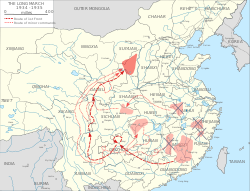This article has multiple issues. Please help improve it or discuss these issues on the talk page . (Learn how and when to remove these messages)
|
Chinese Soviet Republic | |||||||||||
|---|---|---|---|---|---|---|---|---|---|---|---|
| 1931–1937 | |||||||||||
| Motto: "Proletarians and oppressed peoples of the world, unite!" [n 1] | |||||||||||
| Anthem: "The Internationale" [n 2] | |||||||||||
 Map of the various soviets comprising the Chinese Soviet Republic and the route of the Long March | |||||||||||
| Capital |
| ||||||||||
| Largest city | Ruijin | ||||||||||
| Government | Provisional communist state | ||||||||||
| Chairman of the Central Executive Committee | |||||||||||
• 1931–1937 | Mao Zedong | ||||||||||
| Chairman of the Central Revolutionary Military Committee | |||||||||||
• 1931–1937 | Zhu De | ||||||||||
| Chairman of the Council of People's Commissars | |||||||||||
• 1931–1934 | Mao Zedong | ||||||||||
• 1934–1937 | Zhang Wentian | ||||||||||
| Legislature | National Congress of the Chinese Soviets of Workers', Peasants' and Soldiers' Deputies | ||||||||||
| Historical era | Interwar period | ||||||||||
• Independence proclaimed from the Republic of China | 7 November 1931 | ||||||||||
• Start of the Long March | 7 October 1934 | ||||||||||
| 10 November 1934 | |||||||||||
• Arrival at Shaanxi | 22 October 1935 | ||||||||||
• Disintegration of the Soviet Republic | 22 September 1937 | ||||||||||
| Currency | Chinese Soviet yuan | ||||||||||
| Chinese name | |||||||||||
| Traditional Chinese | 中華蘇維埃共和國 | ||||||||||
| Simplified Chinese | 中华苏维埃共和国 | ||||||||||
| Postal | Chunghwa Suwei'ai Kunghokuo | ||||||||||
| |||||||||||
| |||||||||||
| Part of a series on the |
| Chinese Communist Revolution |
|---|
 |
| Outline of the Chinese Civil War |
The Chinese Soviet Republic (CSR) [n 3] was a state within the Republic of China, proclaimed on 7 November 1931 by Chinese Communist Party (CCP) leaders Mao Zedong and Zhu De in the early stages of the Chinese Civil War. The discontiguous territories of the CSR included 18 provinces and 4 counties under the Communists' control. The CSR's government was located in its largest component territory, the Jiangxi Soviet in southeastern China, with its capital city at Ruijin. Due to the importance of the Jiangxi Soviet in the CSR's early history, the name "Jiangxi Soviet" is sometimes used to refer to the CSR as a whole. [8] Other component territories of the CSR included the Minzhegan, Xianggan, Xiang'egang, Honghu, Xiang'echuanqian, Eyuwan, Eyushan, Shaanxi-Gansu, Sichuan-Shaanxi, and Hailufeng Soviets.
Contents
- History
- Background
- Establishment and growth
- Encirclement campaigns
- The Long March
- Dissolution
- Administration
- Land reform
- Finance
- Taxation
- Postage stamps
- Media
- Historiography
- See also
- Notes
- References
- Citations
- Sources
- External links
Mao was both CSR state chairman and prime minister; he commanded the state and its government. Mao's tenure as commander of a "small state within a state" gave him experience in mobile warfare and peasant organization, which helped him lead the Chinese Communists to victory in 1949. [9]
The encirclement campaigns initiated by the Kuomintang in 1934 forced the CCP to abandon most of the soviets in southern China. [9] The CCP (including the leadership of the CSR) embarked on the Long March from southern China to the Yan'an Soviet, where a rump CSR continued to exist. A complex series of events in 1936 culminated in the Xi'an Incident, in which Chiang Kai-shek was kidnapped and forced to negotiate with the CCP. The CCP offered to abolish the CSR and put the Chinese Red Army (nominally) under Kuomintang control in exchange for autonomy and an alliance against Japan. These negotiations were successful, and eventually resulted in the creation of the Second United Front. The CSR was officially dissolved on 22 September 1937 and the Yan'an Soviet was reconstituted officially as the Shaan-Gan-Ning and Jin-Cha-Ji Border Regions.[ citation needed ]



